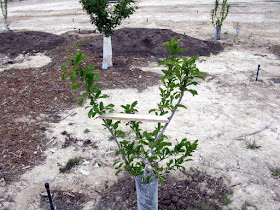Q. This is the second year for my Santa Rosa plum. I attached some garden trowels to some of the
main branches to open – up the tree to a vase shape. Is this a good idea?
 |
| Weights work good for opening up or spreading open a fruit tree like this Santa Rosa plum growing in Las Vegas. Limb spreaders are faster. |
A. Somehow I feel like this was a setup. Yes! If you
follow me long enough you know I like to see flower and fruiting plants without
their branches growing at 45° above horizontal. Many types of plum have narrow crotch angles and their canopy needs
to grow more openly.
 |
| Some trees grow upright even if they aren't supposed to like pears, many plums, Asian pears and their ornamental counterparts. Good crotch angles form a "U" when they are strongly attached to a limb or trunk. Weak crotch angels form a "V" when the angle is too weak and the limb will split when it gets some weight on it. The branch in the back is growing straight up. No, no, no. Get rid of it now! (and that little one in front, too!) |
Branches
growing at 45° angles produce an optimum balance between growth and flower or fruit
production. Branches growing horizontally or downward may flower well but don’t
grow fast. Branches growing nearly upright (vertical) grow very rapidly but
they are slow to flower. The tree intends for this type of growth to give it
height. Some trees grow extremely upright (most pears for instance) and the
limbs should be spread apart and pruned to outward growth in mid to late spring
to slow it down and improve flowering or fruiting.
 |
| When young trees or young growth grows too close together and upright, use a limb spreader to push the branches apart for one season of growth. |
Plants don’t
care if their limbs are spread to 45° by weights or another method. I prefer to
use “limb spreaders” of different lengths (4, 8, 12 and 18 inches). They are
faster and less adjustment is needed. You can make them with forked ends out of
one-inch wood lath and even wooden paint
stirrers. They should be strong enough to hold branches apart and not break while
doing it.
Be
careful spreading limbs apart early in the season when they easily split if
bent too far. After the new growth in the spring is an inch or two is the
perfect time to bend limbs to their proper angle and either a hang weights, use
limb spreaders and prune to outside growth to open the canopy wider. After one
season of growth in this position they can be removed.

No comments:
Post a Comment